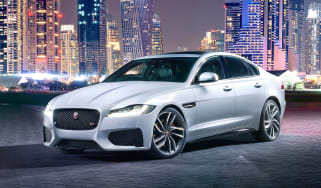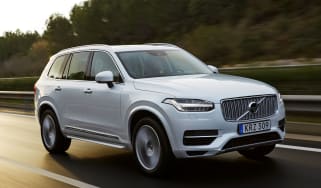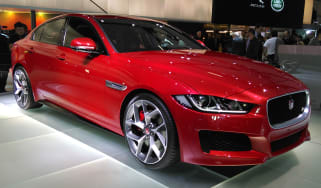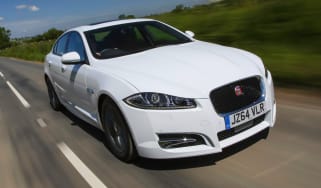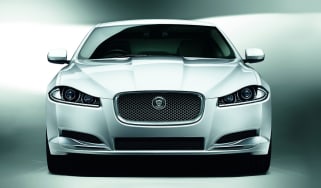Jaguar XFR saloon (2009-2015)
"The Jaguar XFR is great to look at and even better to drive thanks to its glorious supercharged V8 engine."
Pros
- Stylish design
- Comfortable suspension
- Very impressive performance
Cons
- Expensive to run
- Lack of rear headroom
- Not as fast as a BMW M5
The Jaguar XFR is a high-performance version of the standard Jaguar XF saloon. It has a sporty but understated body designed to make it stand out from the rest of the range, as well as an extremely powerful 503bhp supercharged V8 petrol engine. Rivals include the BMW M5 and Mercedes E63 AMG, with the Jaguar proving just as much fun to drive despite its slight power disadvantage.
Fuel economy is unlikely to be a priority for buyers drawn to a saloon car with more than 500bhp, which is just as well, as a claimed figure of 24.4mpg and sky-high road tax bills make the XFR an expensive ownership proposition. Running costs aside, the car should be a pleasure to live with. The interior is stylish and feels solidly built, the suspension is comfortable and the handling and speed that are always available will please driving enthusiasts.
The BMW M5 is still the best drivers' car in this class, but the XFR's lower price, desirable badge and thrilling performance certainly make it worth considering as an alternative.
MPG, running costs & CO2
The XFR's prodigious performance makes for big fuel bills. Fuel conomy of 24.4mpg means owners should prepare for their wallet to become thick with petrol station receipts and the car's CO2 emissions of 268g/km equate to an eye-watering annual tax bill of £505.
More reviews
The combination of the car's size, weight and extremely powerful engine explains its poor efficiency, but it also means you can expect some serious stress on parts of the car like the rear tyres and brakes. A trip to your Jaguar dealer for a service won't provide any respite from big bills, either.
Engines, drive & performance
The Jaguar XFR's 5.0-litre supercharged V8 petrol engine produces 503bhp and makes the car seriously quick in a straight line. Considering the car weighs almost 2,500kg, its 0-62mph time of 4.7 seconds is pretty impressive. It sounds like a sports car and the engine is powerful enough to make overtaking effortless. The car is limited to a top speed of 155mph, unless you choose the Speed Pack, which raises this to 174mph.
The rival BMW M5 is even more powerful and is capable of 0-62mph in 4.3 seconds. While the XFR costs around £8,000 less than the M5, Jaguar also makes the 543bhp XFR-S, which gets closer to the 560bhp of the M5. The XFR-S doesn't look such good value at £3,000 more than the M5, though.
The XFR deals with corners at speed beautifully, making it feel smaller and lighter than it actually is. The adaptive suspension system helps the car's handling, but not at the expense of comfort. Such a powerful car does require care, especially in the wet – all of that power for acceleration can overwhelm the grip of the rear wheels if you get too enthusiastic with the throttle.
Interior & comfort
The interior of the Jaguar XFR is modern and stylish, with leather sports seats and plenty of tactile materials. There's a touchscreen infotainment system and blue lighting that gives the cabin a sense of occasion. A circular gear selector rises up from the transmission tunnel when you turn the key and air vents automatically open, too. Overall, the interior of the car is elegant and feels plush.
The XFR is fitted with Jaguar's 'Adaptive Dynamics' suspension system, which monitors the speed, steering and movement of the car's body and adjusts to suit the road conditions and your driving style. On a motorway cruise, the ride is softer and more comfortable, but the system can also firm up for improved handling when you're on a twisty road. It means the car is comfortable despite its sporty nature.
Practicality & boot space
You can't specify a puncture repair kit with the Jaguar XFR, so the only option is a space-saver spare wheel, which is definitely preferable to tyre foam. But the spare wheel robs 40 litres of bootspace, so the XFR makes do with a not-inconsiderate 500 litres of luggage room. This is still a useful size, swallowing several large suitcases, and is only 20 litres smaller than the boot in the BMW M5. The rear seats in the Jaguar fold down to free up 923 litres of space.
The car is spacious and comfortable for occupants in the front, but tall passengers in the back may feel a little restricted by the roofline, as it slopes dramatically towards the rear of the car, cutting into headroom. The transmission tunnel robs the middle seat passenger of legroom, too, so for longer journeys it's probably best reserved for children.
Reliability & safety
The standard version of the XFR, the Jaguar XF, came 15th out of 150 cars in our Driver Power 2014 survey, showing that owners are very happy with their cars. Unfortunately, its mark for reliability has started to slip and was the car's weakest point – it came 80th out of 150 in the reliability category. Similarly, Jaguar itself achieved an excellent second place overall out of 33 manufacturers, but only managed 15th place for the reliability of its cars.
The XF was crash-tested by Euro NCAP in 2011 and was awarded four out of five stars, which is fairly disappointing when you consider most of its rivals scored the full five. It does have six airbags and electronic stability control, but the main reason for its lower-than-expected score was poor pedestrian protection.
Price, value for money & options
The cheapest Jaguar XF starts at around £30,000, so the £65,000 asking price for the XFR means you'll have to be pretty sure you'll regularly exploit all the extra power in order to justify the extra spend. The car has 57bhp less than the BMW M5, but its 503bhp will be more than enough for most drivers. It's also around £8,000 cheaper, although you should bear in mind that the BMW will depreciate slower.
Standard equipment in the XFR includes LED rear lights, climate control, heated leather sports seats, 60:40 split-folding rear seats, a seven-inch touchscreen display, sat nav, DAB digital radio and cruise control.
There are plenty of options available to XFR buyers and the overall cost of the car quickly skyrockets if you choose more than one or two. Alternative alloy wheel designs cost around £500 and some entail the selection of a bodykit that costs thousands rather than hundreds of pounds extra.
There are also various upgraded interior options that can cost upwards of £1,000, as well as equipment like bright xenon headlights, digital TV, adaptive cruise control, city braking and a blind-spot monitoring system.





